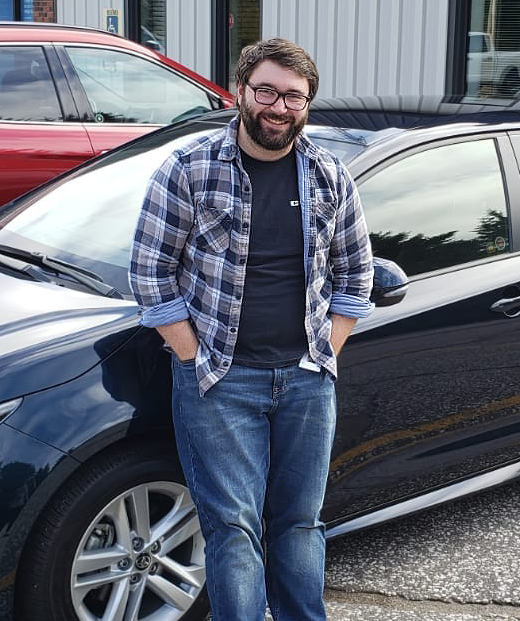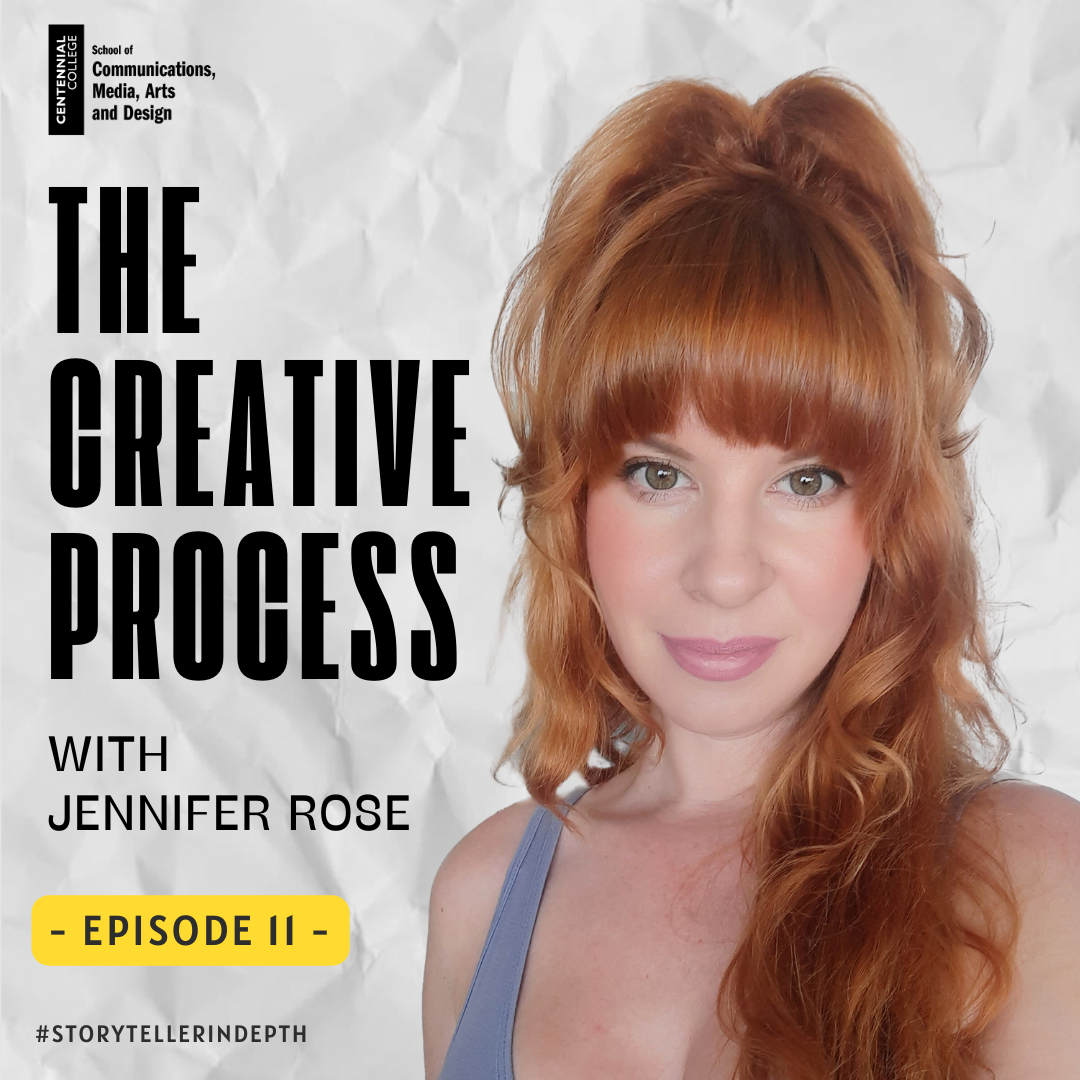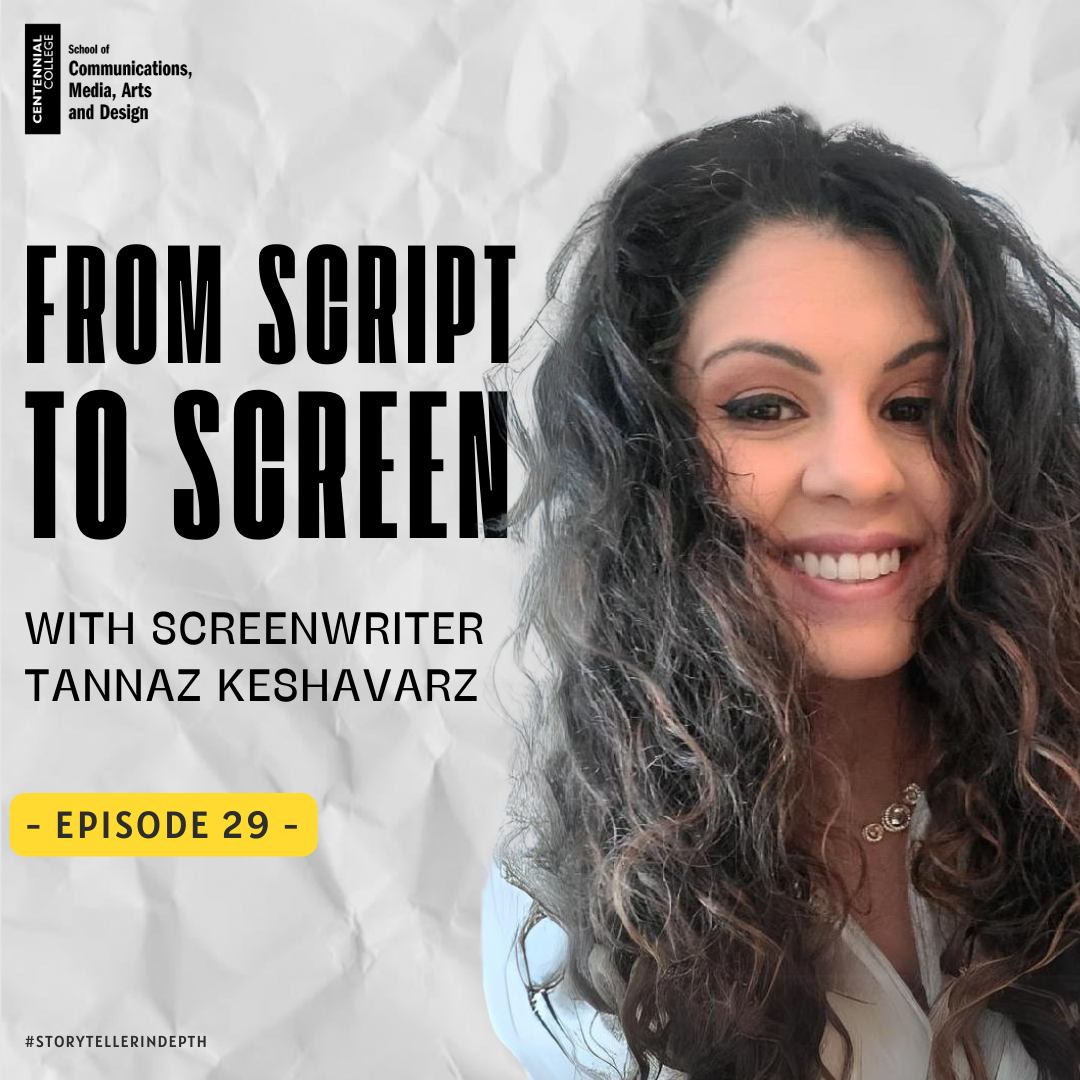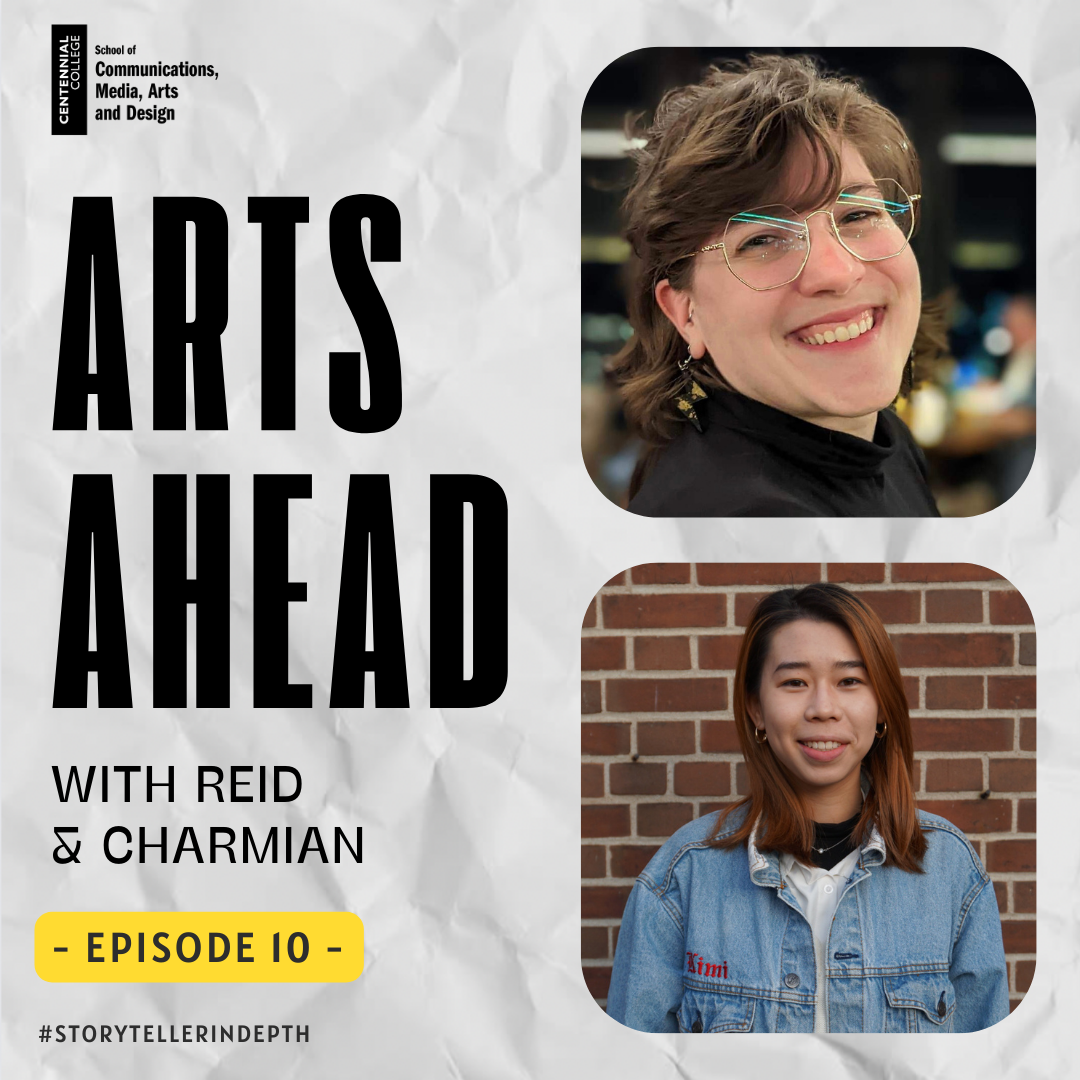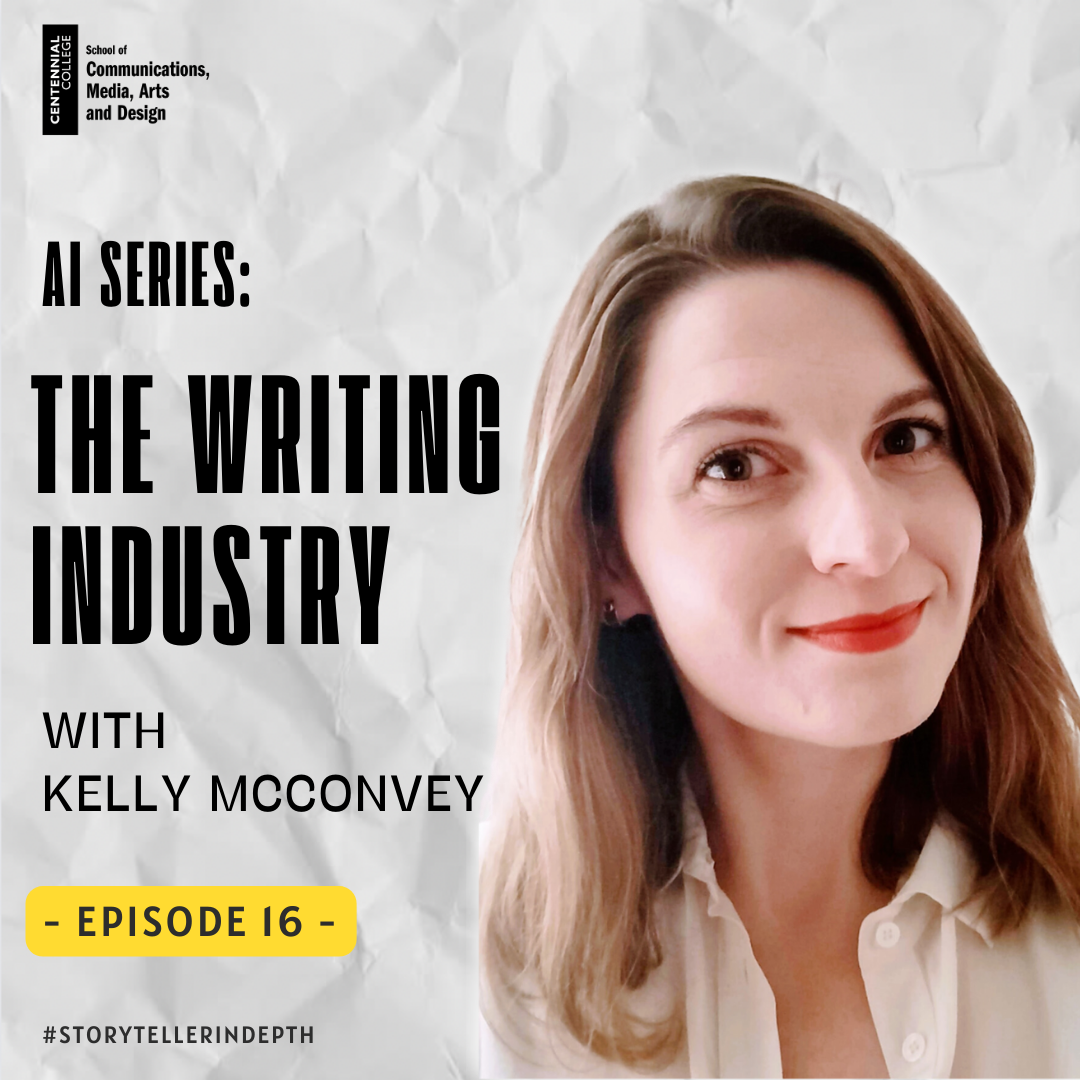Episode Transcript
Speaker 0 00:00:00 Hello and welcome to Storyteller in Depth, a podcast where we go behind the scenes to learn more about the School of Communication, media Arts and designs, people, places and things. I'm your host, pat Quigley and in today's episode we have Jennifer Rose, a recent graduate of our Fine Arts studio program. Jennifer is an artist who adds such a great deal of attention into her pieces and one of her pieces sheds light on such an incredibly personal topic, which we will discuss in just a little bit. In fact, this piece won her the Marilyn Scott Academic Achievement Scholarship, an incredible accomplishment to hear more about this, her advice for artists, her experience in the Fine Arts Studio program and more. Be sure to stick around. And thank you Jennifer, so much for being on the podcast today.
Speaker 2 00:00:59 Hi, pat. Thanks for having me.
Speaker 0 00:01:01 Yeah. So before we kind of get started with, uh, all the fun and the interview portion of things can just, uh, talk a little bit about yourself. Who is Jennifer Rose?
Speaker 2 00:01:11 Yeah, so Jennifer Rose is a student currently at Centennial College. Um, it's my second program there. So I've done the art design fundamentals program. I'm now finishing up the fine arts program and I'm a multidisciplinary artist, uh, who returned to school as a mature student and loving every minute of it.
Speaker 0 00:01:32 Nice. So what inspired you to become an artist and when did you first realize that you wanted to pursue a career in fine art?
Speaker 2 00:01:39 Yeah, so I've always been a creative person, um, but my interest in the arts has been more like varied throughout my life. Um, and it still is <laugh>, uh, cuz I do like to do a lot of different things as a multidisciplinary artist. So we do all kinds of different mediums. So my early life was spent doing a lot more like acting and performance. Um, I was really into drama and theater. And then I also loved making the sets and props that came along with these theater performances and making costumes as well. Um, and I've always excelled in visual arts in school, so like drawing photography, it's just what I've always done. Um, and then life just took me on a variety of different paths as it does. Um, I had to work full time to support myself for a while, so I worked as a bartender and a server.
Speaker 2 00:02:28 Um, I had office jobs, which I really did not like those at all. It was not for me. Um, and then I ended up running a small carpentry and repair business for about six years. Um, so all the while I'm doing this for work, I'm like imagining and living this different inner life. Um, so I'm making movies and images in my head all the time and constantly writing, um, and I'm doing photography. So this creative way of being is just sort of my obsession. It was, it is now. Um, so then two things happened. I went through a pretty life altering traumatic event or series of events over the course of a few years. Um, so this changed a number of things for me physically and mentally. Um, and then recovering from that covid hit. So I was looking at my life and I just realized that it wasn't the one that I had built that I had intended to build for myself. Um, so I just decided rather impulsively to take the leap and I pivoted my life and career. Um, and I just dove in head first. So I joined the ADF program at Centennial College that really got me passionately interested in pursuing this. Um, and then I continued in my current program. Here we are.
Speaker 0 00:03:46 Yeah. And it's been obviously a lot of fun, right?
Speaker 2 00:03:50 Oh yeah, it's been tons of fun. It's, um, it's stressful and fun being a mature well being any student. Um, but being a mature student is, I think can be more challenging depending on your situation. So for me, I had to make sure I was financially set to be able to do the things that I wanted and I had to work during these moments. Um, but the fun came when I really got to dive into every project and I was encouraged a lot in my program to be different and like to explore the things that I wanted to do. And that's when I really started to find like, this is my, my rhythm, you know? And I had a flow going and uh, and yeah, I've been loving every minute of it.
Speaker 0 00:04:34 Cool. I've checked out a little bit of your artwork from some of the articles and stuff that have been out on Centennial College's website, but how would you describe your artistic style using only three words?
Speaker 2 00:04:45 Three words is tough, um, because I talk a lot <laugh>, but, um, so because my style has changed and developed quite a bit over the years, um, that's one of the things that I keep revisiting for myself as well. Um, and because I changed, but I would say so as of today, abstract definitely first and foremost and existential and beautiful. Hopefully I try to create work that has existential concept and maybe deals with tougher themes, but that is visually still beautiful to look at and that draws people in.
Speaker 0 00:05:21 Right. And would you be able to give an example of a piece of artwork that you've created that embodies those three words?
Speaker 2 00:05:28 Yeah, so I just created a piece and finished it and, um, so it's, uh, our listeners can't see it. It's actually right there on the wall behind me, you can see it. Um, so I did this for a group show for fine arts. Uh, we have sort of an exhibition each semester that we've done the program. Um, so we did this at Leslie Grove Gallery, which is in Leslieville Toronto. And the show is called Iceberg. So the theme was exploring our sort of diverse inner lives, um, that we all live. And I just mentioned before that my inner life is, uh, much more active <laugh> than my outer life a lot of the time. Um, so I created a photo-based work that's called Held Under. And so this was reflective of my inner life, um, and how I have experienced the world, especially since these sort of more traumatic or life-changing experiences that I had.
Speaker 2 00:06:20 Um, and then subsequently from that I was diagnosed with post-traumatic stress disorder. So visually I, it reflected like a collage of photographic images of myself, sort of as though I were trapped under ice. Um, which I thought worked well with, with the literal and the figurative theme of that. Um, and so, you know, it's a reflection of what it's like to live with this condition. Um, so sometimes like the ice is thinner or it melts and other times it's just sort of, you know, uncomfortable to live day to day. So I wanna reflect that, but the piece is more like not meant for an intended statement, it's more of a reflection that people can see a part of themselves in. Um, so, you know, it's meant to be experienced by the viewer on their own personal level for them to connect with it. So it's abstract in its form, in the way it appears. Um, and it definitely speaks to our existence, you know, how we experience ourselves and it reflects beauty cuz there's, you know, frozen flowers in it. And the composition was put together with a lot of thought. Um, and so it's sort of, it's showing the beautiful moments of memories that we relive through these experiences.
Speaker 0 00:07:31 Wow. And like, so how do you come up with the themes and the concepts that you explore in your work and and how has that evolved over time?
Speaker 2 00:07:41 Yeah, um, it's definitely evolved. It's changed quite a bit as I have, um, as most of us do. So like what I just described in that piece, I'm really most interested in exploring and understanding and like conveying the truth of the human experience. So that experience is many things and it's very, um, complex. And being someone who's very tuned in to the emotional experiences of myself, my inner world and other people, um, you know, I want to make a connection with people through this work. So I explore these themes, you know, and they change over time. Um, so I explore like overwhelming feelings of guilt and maybe even existential guilt and, and fear, um, but also joy and awe, you know, I, the most powerful emotions I ever feel are ones where I'm just completely in awe of like the beauty of everything, you know, of life itself.
Speaker 0 00:08:41 And how do you select the materials and mediums that you use in your artwork? Like, I know you talked about photography, but like, like what do you use and, and what factors in influence those choices?
Speaker 2 00:08:52 Um, so money <laugh> is a big factor Yeah. In what I choose. So I mean, as a mature student, and I've returned to school in my thirties, um, and I also live alone, so I wasn't financially able to always make the pieces that I see in my head. Um, you know, I have entire short films going on up here that I can't necessarily put out as a tangible thing to the world yet, um, someday. So I do like to paint and I make mixed media pieces as well. And sculpture, I mean, I really am multidisciplinary, um, just in that I'm sort of constantly changing. Um, but photo and film based work allowed me to work digitally for the most part. So I really focus on those photo-based pieces. Um, so that saves a lot of money on materials, which is more the practical side of it, but more importantly, it conveys like a realness of a moment of or experience that I, you know, then explore and abstract and exploit maybe even, um, to create this reflection and this artistic piece. And I get to do it over and over again, and I get to tweak it and change it, um, you know, as much as I want. So it's a very freeing medium to choose. And it's also something that people think of as being a very literal snapshot of a moment, but it can become whatever you want with technology. We can, you know, make a fine art piece out of a simple photograph. So yeah. So that's why I choose that for the most part.
Speaker 0 00:10:20 Awesome. And like, what, what keeps you motivated and inspired to continue doing art?
Speaker 2 00:10:29 So I think a lot of what I do, I've come to know is called process art. So it's not so much about having a particular creative vision, um, or end goal that I need to accomplish for each piece. Um, but it's more about the process of creating the work and like what happens along the way, um, that's most important. So my motivation and inspiration is sort of everything around me, but particularly the quieter places, um, around me and sort of walking through the forest full of life and, you know, just experiencing what my place is there, you know, how do I feel in that space? Do I have a place? It's usually what creates the peace. So the motivation isn't necessarily something external as much as it's just doing what I desire to do. Mm-hmm. <affirmative>.
Speaker 0 00:11:19 And do you, like, I know for myself, I end up with these creative blocks sometimes where I'm not able to work through them. And what, do you have any strategies that you use to overcome these mental blocks?
Speaker 2 00:11:33 So, in terms of a creative block, I, I like, I don't ever feel creatively blocked, so to speak, um, except when I'm required to create work that's not authentic to me. Um, so if I have no true inner drive to create whatever the pieces I'm being asked to make, or if it isn't communicating my own original idea or at least interpretation of that in some way, then it's really difficult to do. Um, so in my, like, I somewhat am required to do this in school, as you know, you don't always get to pick and choose the projects that you do, which I think is really good for exercise, but outside of that, even commission to work with a client is about more communicating what I truly see and feel and like finding an alignment with that other person. So creative block for me, really only happens as a clue that I'm on the wrong path. And if I just go through the process of creating the art and letting it be, instead of seeing it as an end product I'm trying to produce, then I generally don't feel blocked and I can just let things be.
Speaker 0 00:12:46 Hm. That's, that's some really, really good advice that I know for myself. I'm gonna take back and, and hopefully apply into my career and my life. Um, but what advice would you have to give to aspiring artists who are just starting out their careers?
Speaker 2 00:13:00 Oh my goodness. I mean, I am too. Yeah. Um, but so I'll boldly say, do whatever you want, would be my first piece of advice. Just do whatever you want to do, be authentic to yourself in what you do. Um, do it now, don't wait. And I'm saying that as someone who did wait a long time, maybe unintentionally, but the moment presented itself for me to do something, and I did it right away, and it's changed my entire life. Um, and then also to learn, I had to learn this, learn to accept critiques and criticism in a balanced way. So understand the source of the information, who is it coming from, where is it coming from? Consider it and then do whatever you want anyway. <laugh> ultimately, because not everyone's advice is going to be the same, it's all gonna be different. So weigh those critiques, look at it, you know, in terms of maybe your composition, uh, or technical skills that you can enhance. But other than that, don't necessarily take the advice to change what your concept is or what your work is. Should be my catchphrase now. Do whatever you want. That's my advice, <laugh>.
Speaker 0 00:14:15 It's good advice. And also, like, I just, uh, take everything with a grain of salt, right? Like yeah, you know, people are gonna have their opinions about your work, but you don't always have to act on those things. Sometimes that advice is not always the best advice. Yeah, right. Especially in your creative process.
Speaker 2 00:14:34 Yeah. And I mean, it's different for every person. So something that might be excellent advice to give to one of my peers may not work for me because it's, we don't have the same goal, we don't have the same artistic vision. So yeah, just weigh everything as you said. Take it with a grain of salt.
Speaker 0 00:14:49 Yeah. So how do you think that the Fine Arts Studio program has helped you with your career as an artist?
Speaker 2 00:14:56 I've been thinking about that a lot lately because I'm coming to the end of my program, and when you go to school, there are inevitable stressors and frustrations, but as you come to the end of it, it's one of those, oh, I didn't know how good I had it <laugh>, you know, and how much I really enjoyed this program. So the most important things that I gained looking back have been so faculty in the program take time to teach you and to encourage you to develop technical skills. And that's something that almost feels like a form of criticism when it happens Bec, but what they're doing is they're trying to help you grow. So if you're someone like me who maybe came in a little defensive or guarded, you'd be like, well, I'm trying my best here, you know, but I learned from them that by taking that and actually trying to implement it into my work, um, that I did become stronger in terms of my technical skills.
Speaker 2 00:15:51 So that was a huge bonus for me in feeling and developing confidence in what I was doing. Um, so you may have, you know, concept and vision, but, um, do the academic portion that they're trying to teach you as well, so you can create what is objectively a good composition. Um, and I meant just incredible influential people, um, through the process. So my peers and faculty, they not only influenced, um, you know, what I was doing in terms of work, but they also supported me and what I wanted to do. And, you know, they, the fact that I often wanna take a different approach, as I had said before. Um, and also it just puts you in touch with, you create this network of artists, you meet people at other galleries. I mean, it is like most things where it's what you make of it. So if you really go into this program and you're, you're open and you're driven to do the best that you can do, I think it really benefits every individual in their own sort of specialized way.
Speaker 0 00:16:51 Right. What lessons do you think you're gonna take with you after you're, you graduate and after you're done the program?
Speaker 2 00:16:58 A a lot of them are personal lessons, like I had said. So learning to, so from faculty, I learned to look critically at the work that I was creating. So I may have created a piece that was very driven by my emotions or my personal experience. And it, it's like, you make it very precious, and then when someone has a criticism of that, you think, oh my goodness, that's a reflection about myself. But it's not, they're on your side and they're trying to help you improve. So the biggest thing from faculty was being able to objectively look at a composition, see where it needs to be improved. Um, and also from my peers, I learned a lot about being patient, um, because I'm someone that tends to drive really hard and wants to get things done very quickly. And I learned that stepping back and being patient with the process with other people or with myself really, and learned that from friends I made in the course. That that's probably the biggest takeaway from the whole experience was that I developed into, I think a better and stronger person. And now I can take that out into the world and feel more confident.
Speaker 0 00:18:11 Right. Switching gears a little bit now, um, you have an art piece that you submitted for the Marilyn Scott Academic Achievement Scholarship. Can you talk a little bit about that?
Speaker 2 00:18:24 Um, yeah. So this is definitely what I would call process art, like we were saying before. Um, meaning that the process of making it was really the biggest component of it. So it was quite cathartic to create, but the piece began as a research based piece that then developed into this meaningful self-exploration, uh, of myself. And also what post-traumatic stress disorder is, what is the nature of it? So many, if not most people, you know, think of this condition as a purely mental or psychological one, but it is physical and it's neurological, um, as what we see in what research shows. So the visual representation that I did in the piece is what the experience of the brain is, what the changes in the brain are, and then using that to reflect the experience upon the individual, which of course changes for everyone, but with certain unifying characteristics. Um, so when I was diagnosed, I felt a bit of relief because it was a confirmation and acknowledgement, um, of why my life had become barely livable really at that point. Um, but it also created more confusion and stress in that after that diagnosis, I still didn't really understand what it meant, what was that, what was going on? Um, so I created this piece as sort of a private introspective research based project, um, that empowered me to understand physically what that was and therefore understand myself and, and also to express myself through the piece.
Speaker 0 00:20:04 So what was the experience for yourself to create this, this work of art?
Speaker 2 00:20:11 Yeah, so again, it was a very sort of cathartic process. I didn't really have a plan when I set out. I just put up a blank canvas. I knew it was gonna be a painting, and I knew probably gonna have some mixed media elements. And then I knew that I wanted to discover something new before I did the piece. So instead of, usually the process will be sort of mapping out, oh, here's exactly what I'm going to do. And then I created in a visual form, this was, we're not gonna worry about the visual form. We're gonna find the information that makes us feel like we understand this. And so the process was more really doing research. It was, you know, I pulled up a lot of medical journals and, um, references, images of brain scans. So it was actually a very, uh, almost non-artistic process really for the first like 60% of it.
Speaker 2 00:21:06 And then with all that information, I thought, okay, so the change in the brain, the change in the way, you know, your neural connections, uh, the way that they change with this disorder, that's what I wanna highlight. And so then I went into <laugh> kind of a dark place, like an upsetting place when I created it, and I just painted it with sort of abandoned. And by the time I was done, I looked at it and I felt very relieved. I felt satiated. Um, and so that's not everyone's process, but that is mine and that process art, um, in what process art is, is that you sort of just let go and let the work come to be. And, uh, it's more chaotic than some people's <laugh> approaches, but it works for me and it especially works, I think if you're doing a very emotionally driven project,
Speaker 0 00:21:59 What, what kind of messages do you want those viewing your work to take away from it?
Speaker 2 00:22:07 Um, I mean, as far as what it looks like, the theme, when you see the piece, you know, it, it speaks to angst and fear. Um, you know, there's a visual clue to this sort of despair and suffering that someone experiences, but that's actually not what I wanna convey to other people as a message. Um, so this piece was created for me as a cathartic experience and, uh, expression before I ever knew about or submitted for outside consideration. So I would want anyone viewing the piece to take away that these experiences are real. Um, there is empathy, and I think if you look at it and it resonates with you, then we've made a connection through that piece. And if you think and feel something completely new because you don't have that experience, then we've still made a connection. So I feel like that's kind of, that's what drives me, and it's what life's all about really, is finding and making that connection with people.
Speaker 0 00:23:11 Take us back to the moment where you found out about, uh, receiving the scholarship <laugh>. What were your thoughts and feelings in that moment?
Speaker 2 00:23:19 I was so excited. <laugh>, like, I was so excited. Um, I mean, like, there were tears, you know, I think I was alone when I found out. Um, so just me sitting in my little 250 square foot space here, there were tears. You know, there was moderate celebration and I just felt like it's happening. You know, it felt really satiating in that way. Like, my work is being seen, it's meaningful to someone other than myself. Um, and it felt fantastic. However, I will say, having said that, that you don't need necessarily to win an award or get recognition for your peace, like it truly only matters that the work is meaningful to you. Um, and the recognition of that is a bonus. Um, and you should go after these successes because they open doors for you. Um, and it's sharing your work, which is really important. But, you know, at the end of the day, uh, my new catchphrase, do what you want, you know, do it for you and recognition will come.
Speaker 0 00:24:20 Right. Kind of to, to finish off the interview, if you could create a piece of art that, uh, would be seen by everyone in the world, what message would you want it to convey?
Speaker 2 00:24:33 That's a really tough one, because I can't think of a single message that would resonate with anyone. And I think I don't really intend to send a message through my work. I think I intend to offer a reflection of ourselves, our human experience collective and individually. So I don't think that I have a message for anyone. I mean, who are any of us to send a message rather than maybe I would try to make a piece that was large scale <laugh> so noticeable and maybe reflected something that could reflect everyone's individual experience. See, now Pat, you're giving me ideas for a large scale mirrored sculpture, you know, on top of a mountain. Um, but yeah, I would try to create something that would be completely different for everybody, and it's open to interpretation and let the message be whatever you get from it,
Speaker 0 00:25:33 Do what you want,
Speaker 2 00:25:34 Do what you want.
Speaker 0 00:25:35 Exactly.
Speaker 2 00:25:36 There's the poster. <laugh>. Yeah.
Speaker 0 00:25:39 Well, thank you so much, Jennifer. Best of luck in the last couple weeks going to in your program. And uh, yeah,
Speaker 2 00:25:45 Thank you, pat. Thanks for having me. This was really great.
Speaker 0 00:25:56 Thank you so much, Jennifer, for being on the podcast. This was such a great conversation. We have a bunch of great episodes on the way, so be sure to follow our podcast on your favorite podcast streaming service, so you'll be alerted of our next episode. And if you liked this episode, leave a comment on our Instagram post or tweet at us at Story Art Center. Until next time, I'm Pat Quigley and this is Storyteller in Depth.
